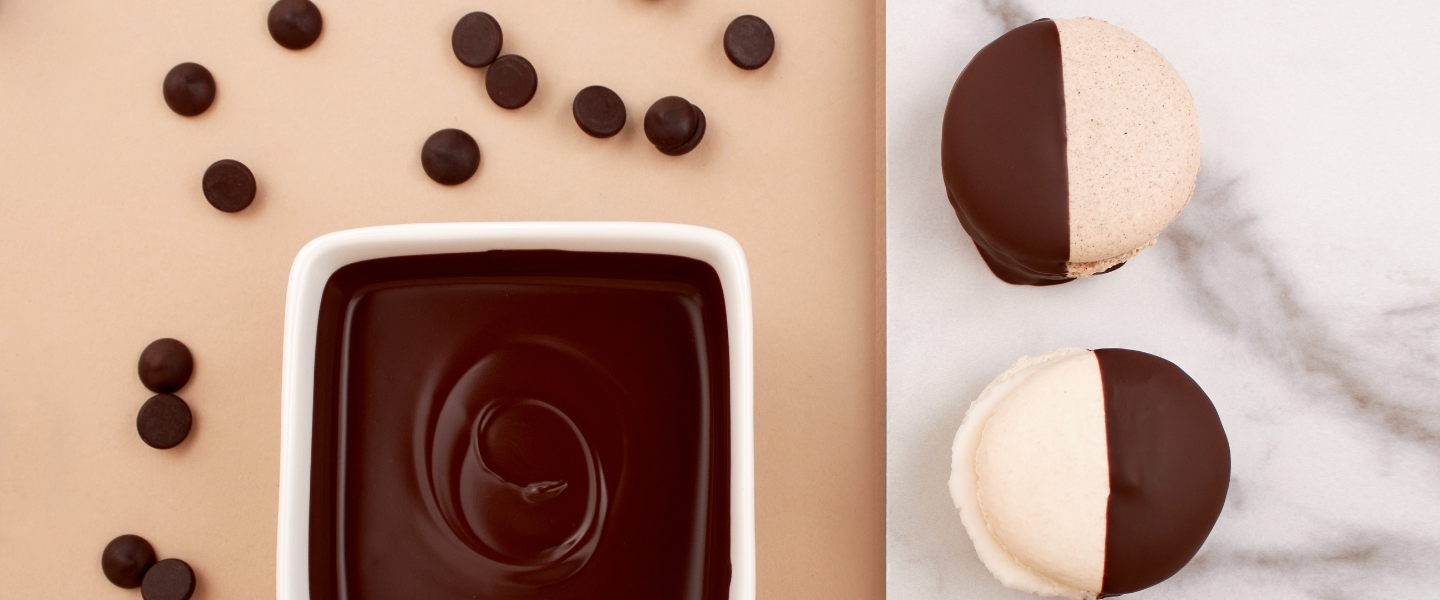How to temper chocolate
- Mar 24, 2023

Ready to dive into the couverture chocolate world, but overwhelmed by the idea of tempering? We’re here to help!
Similar to baking, when tempering you must follow precise steps in order to achieve optimal results. We cannot emphasize this enough. There is no room for error when it comes to tempering chocolate.
We’ve put together a set of simple instructions to help you learn to temper the easy way!
Before we dive in, it’s important that you understand the basics of tempering is & why the process is necessary.
Tempering is simply a method of temperature control where you heat, cool & reheat the material to specific temperatures in order to achieve a desired finish (similar to the process that metal goes through.) In this case, with chocolate, we are looking to achieve a shiny finished product with a sharp snap! If you just simply melt the chocolate & let it cool, you will be left with a lackluster finished product that’s soft & dull.
Let’s break down the scientific explanation in an easily digestible format.
A solid piece of chocolate is created by specific molecules in crystal form. When you melt chocolate, the molecules in the chocolate structure fall out of place & some of these crystals disappear . When the chocolate starts to cool, the molecules start to align again & some crystals start to form again. The problem is, the molecules don’t always align back to their original order & depending on the temperature the correct crystals might not grow back. The only way to ensure that they do, is to temper the chocolate properly. This will leave you with proper crystallization & a chocolate that is strong & has a shiny finish .
Example:
Let’s say a chocolate molecule (or different types of crystals) is made up of:
ABCABC
When you melt chocolate, the molecules separate & spread out. When the chocolate is overheated, some molecules (or crystals) may even disappear, leaving you with something that looks like this:
A C A B
If you let the chocolate cool down, without properly tempering (reaching the proper temperatures), the molecules try to settle back into place, whether they are in the correct order or not. While this should create crystallization, if there are any molecules missing some crystals cannot be formed.
CABA
If you properly temper the chocolate, the necessary crystals will grow back & the molecules will know exactly what order to come back into place.
ABCABC
Now that you understand why, let’s dive into how to temper chocolate!
There are a few different methods to tempering chocolate, the most common being seeding & tabling.
Seeding Method:
- Separate ¾ of the chocolate that you're planning to melt into a bowl.
- Use a sharp knife to chop up the remaining ¼ of chocolate into smaller pieces. Set aside for later use (Step 4.)
- Using either a double boiler or the microwave, heat the ¾ of chocolate until it reaches 110°F.
- Remove the chocolate from the heat & add in your reserved chopped chocolate. Mix well until the chocolate has cooled down to 84°F.
- Put the chocolate back on your double boiler (or back in the microwave) for a short amount of time until the temperature comes back up to 89°F.
- Your chocolate is now in temper! This will be your working temperature window!
- To remain in temper, don’t let the temperature fall below 88°F or go above 90°F.
PRO TIP: You can do a quick temper test by dropping some chocolate onto parchment and letting it harden for about three minutes. If you tempered properly, you should end up with a shiny piece of chocolate that snaps when it’s broken in half.
If your chocolate hasn’t dried after 3 minutes, or it dries dull & pliable, you likely didn’t temper it properly. We weren’t kidding when we told you that this is a precise process.
The key is to hit all 3 temperatures exactly. If you go over or under, you will not achieve optimal results.
Tabling Method
This is the traditional way for artisanal chocolatiers to temper chocolate. The tabling method requires a marble slab or countertop, a palette knife & a bench scraper.
Melt all of your chocolate using a double boiler until it reaches 110°F.- Remove from heat & pour the chocolate onto your marble countertop. This coolness of the marble is what is going to help cool the chocolate down.
- Using a palette knife & bench scraper move the chocolate around the cooling slab using a spread & scrape motion. The key to cooling it down consistently, is to keep your chocolate in constant movement.
- Once the chocolate has cooled down to 84°F, put it back on the double boiler until it has reached 89°F.
The tabling method is certainly time consuming & can also be physically straining, making the seeing process more common among beginners.
Microwave Method:
The easiest (& possibly most unconventional method) for home bakers to temper smaller quantities of chocolate, is by using the microwave method! Chocolatiers might not approve of this method, as it’s not technical in nature, but it works!
PRO TIP: This is the same method we use to melt compound coatings!
- Use a knife to chop your chocolate into easy to melt pieces, or as small as you can.
- Using a microwavable bowl (we prefer plastic or silicone) slowly melt your chocolate in 30 second intervals. 30 seconds in, remove & stir, 30 seconds in, remove & stir.
- Each time you stir it, you will want to take the temperature of your chocolate.
- Make sure it never exceeds 90°F.
The key to the microwave method is to NOT take your chocolate out of temper. By slowly melting it & keeping the chocolate below 90°F you are able to melt couverture chocolate in the microwave while keeping it tempered (LIFE HACK!).
Now that you know how to temper chocolate properly, it’s time to pick out the perfect chocolate!
Our favorite chocolate to temper is our very own Eleven o’one Line! We also carry other couverture chocolate brands on our website that we think you might like such as Callebaut, Peters & Van Leer.
If you think tempering sounds like too much work, we have a fantastic lineup of compound coatings that don’t require any tempering. Just simply melt & let cool! We carry a wide variety of both domestic & European compound coatings to choose from.
We hope this post helps you in your chocolate journey! If you have any further questions regarding which products require tempering, feel free to reach out to our customer service team at info@stovercompany.com or by phone at 724.274.6314




